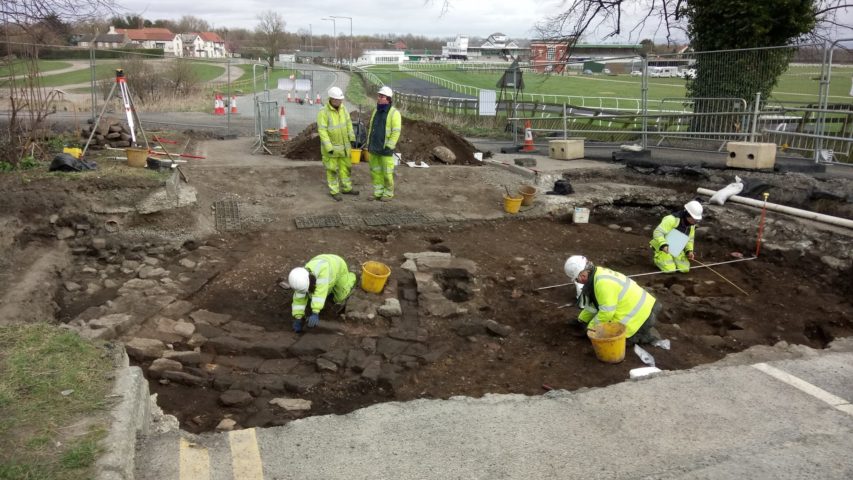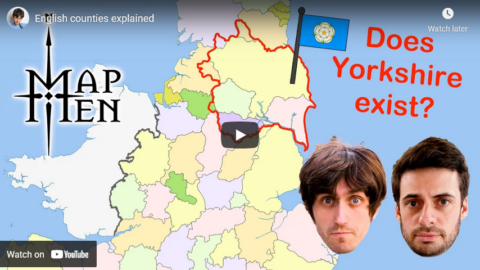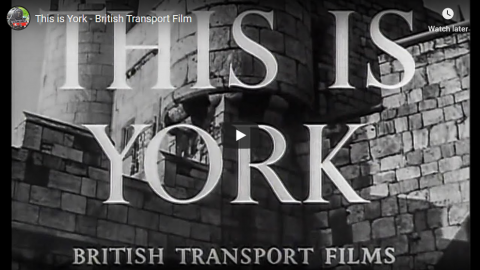Bee Here Now
Published 23 Oct 2023The Stockton-Darlington Railway wasn’t the first time steam locomotives had been used to pull people, but it was the first time they had been used to pull passengers over any distance worth talking about. In 1825 that day came when a line running all the way from the coal pits in the hills around County Durham to the River Tees at Stockton was opened officially. This was an experiment, a practice, a great endeavour by local businessmen and engineers, such as the famous George Stephenson, who astounded crowds of onlookers with the introduction of Locomotion 1 halfway along the line, which began pulling people towards Darlington and then the docks at Stockton.
This was a day that would not only transform human transportation forever, but accelerate the industrial revolution to a blistering pace.
In this video I want to look at what remains of that line — not the bit still in use between the two towns, but the bit out in the coalfields. And I want to see how those early trailblazers tackled the rolling hills, with horses and stationary steam engines to create a true amalgamation of old-world and new-world technologies.
(more…)
February 16, 2024
What remains of the “first” steam powered passenger railway line?
December 12, 2023
Rolling a Reliant Robin | Top Gear | BBC
Top Gear
Published 26 Nov 2010Jeremy takes the extreme sport of Reliant Robin rolling to the streets of Barnsley, aided by a string of celebrities who just happen to be on hand to help keep the fabled three-wheeler upright.
(more…)
September 21, 2023
This is York
Jago Hazzard
Published 28 May 2023“Make all the railways come to York!”
(more…)
July 31, 2023
The grim plight of the UK as global BOILING advances
Alexander McKibbin reports on the UK’s latest set of climate-related warnings from the Met Office:
No one who has read and digested this authoritative and comprehensive report can fail to be apprehensive about the future. Harnessing the technological power of its powerful computer modelling system, the Met Office can produce a highly accurate forecast of how the changing climate will affect the UK. It is a truly dystopian projection and one which should ring alarm bells in the top echelons of Whitehall.
Below is a selection of areas highlighted as being at risk if we do not achieve Net Zero by 2030.
Berwick-upon-Tweed
This charming border town with castle ruins and cobbled streets will disappear in the next five years, according to the Met Office. The picturesque Royal Border, Berwick and Union Suspension bridges will all be drowned by an unstoppable and ever-rising River Tweed. Displaced residents will need to find alternative accommodation and it is likely that looting and scavenging will become commonplace.
Kent
Known for centuries as “The Garden of England”, this delightful county currently plays host to gentle hills, fertile farmland and fruit-filled orchards. Country estates such as Penshurst Place, Sissinghurst Castle and Hall Place Gardens are all well known for the scenic views they offer.
Sadly, this will all shortly vanish under burning heat exceeding 200 degrees Fahrenheit. The rivers Stour, Medway, Darent and Dour will slow to a trickle and finally dry up completely. Dust storms and dust bowls will be part and parcel of daily living, as will camels and occasional prickly pear cacti dotted across a barren and arid wasteland. Dartford, the Met Office confidently asserts, will be a never-ending vista of shape changing sand dunes.
Yorkshire
Known to inhabitants as “God’s Own County”, no one can deny the many charms of England’s largest county with a population twice the size of Wales.
Horse-racing is a major attraction and with nine courses to choose from including Thirsk, Wetherby, Redcar and Catterick, no wonder Yorkshire is a popular tourist destination. What a pity that all of these temples to equestrian prowess will be lost to an all-consuming glacier that will blanket the land. The report is not sure whether at 104ft high the scenic Ribblehead Viaduct will avoid being trapped in this icy embrace. It is suggested that refugees should make their way south to seek food and shelter.
February 18, 2023
George Hudson: Railway King or Prince of Darkness?
Jago Hazzard
Published 20 Dec 2020Entrepreneur, politician, businessman, visionary, benefactor, conman. There’s a lot to unpick with old George.
(more…)
January 5, 2023
The injustices inherent in “asymmetrical multiculturalism”
Ed West traces the start of “asymmetrical multiculturalism” to a 1916 article in The Atlantic by Greenwich Village intellectual Randolph Bourne and traces the damage that resulted from widespread adoption of the policy:
“Asymmetrical multiculturalism” was first coined by demographer Eric Kaufmann in his 2004 book The Rise and Fall of Anglo-America, and later developed in his more recent Whiteshift, in a chapter charting Bourne’s circle, the “first recognisably modern left-liberal open borders movement”.
Kaufmann wrote how asymmetrical multiculturalism “may be precisely dated” to the article where Bourne, “a member of the left-wing modernist Young Intellectuals of Greenwich Village and an avatar of the new bohemian youth culture,” declared “that immigrants should retain their ethnicity while Anglo-Saxons should forsake their uptight heritage for cosmopolitanism.”
Kaufmann suggested that: “Bourne’s desire to see the majority slough off its poisoned heritage while minorities retained theirs blossomed into an ideology that slowly grew in popularity. From the Lost Generation in the 1920s to the Beats in the ’50s, ostensibly ‘exotic’ immigrants and black jazz were held up as expressive and liberating contrasts to a puritanical, square WASPdom. So began the dehumanizing de-culturation of the ethnic majority that has culminated in the sentiment behind, among other things, the viral hashtag #cancelwhitepeople.”
The hope, as John Dewey said of his New England congregationalist denomination around the same time as Bourne, was that America’s Anglo-Saxon core population would “universalise itself out of existence” while leading the world towards universal civilisation.
These ideas certainly didn’t remain in New England or even the United States, as Britain has certainly seen just how destructive they can be recently:
Late last year I wrote about the tragedy of Telford, a town in the English midlands where huge numbers of young girls had been sexually abused. Telford, along with Rotherham in South Yorkshire, had become synonymous with this form of sexual abuse, mostly committed by men of Kashmiri origin against girls who were poor, white and English.
This is the subject of an upcoming GB News documentary by journalist Charlie Peters, and it is quite clear, from all the various reports, that grooming had been allowed to carry on in part because of the different ways the system treats different groups.
Had the races of the perpetrators and victims been reversed, this tragedy would almost certainly be the subject of countless documentaries, plays, films and even official days of commemoration. But it wouldn’t have come to that, because the authorities would have intervened earlier, and more journalists would have been on the case.
Sex crime is perhaps the most explosive source of conflict between communities, and most recently the 2005 Lozells riots began over such a rumour. It is understandable why journalists and reporters were nervous about this subject; less forgivable is the way that, away from the public eye, those in charge signal how gravely they view what happened.
Until Peters revealed the story, Labour had planned to make the former head of Rotherham council its candidate for Rother Valley; this week Peters revealed that one of the councillors named in a report into the town’s failures to deal with the grooming gangs scandal has gone onto become a senior Diversity & Inclusion Manager working for the NHS. Presumably the people who hired Mahroof Hussain knew about his previous job, and still felt that it was appropriate to have him in a “diversity and inclusion” position. Again, were things different, would a Mr Smith whose council had been condemned for its handling of the gang rape of Asian girls have landed that job? The whole thing seems as morbidly comic as Rotherham becoming Children’s Capital of Culture.
Such a clear inconsistency can only exist because of socially-enforced taboos and norms which have developed over race. In Whiteshift, Kaufmann cited sociologist Kai Erikson’s description of norms as the “accumulation of decisions made by the community over a long time” and that “each time the community censures some act of deviance … it sharpens the authority of the violated norm and re-establishes the boundaries of the group”. Every time an individual is punished for violating the anti-racism norm, it strengthens society’s taboo around the subject, to the point where it begins to overwhelm other moral imperatives.
Then there is regalisation, the name for the process “in which adherents of an ideology use moralistic politics to entrench new social norms and punish deviance”, in Kaufmann’s words. This has proved incredibly effective; after paedophilia or sexual abuse, racism is perhaps the most damaging allegation that can be made.
Few people wish to be accused of deviance, which perhaps explains why Peters’s story has received so little coverage in the press this week. Again, were the roles reversed, it’s not wild speculation to suggest that it would feature on the Today programme, seen as clear evidence of racism at the heart of Britain. When the Telford story broke, it did not even feature on the BBC’s Shropshire home page.
September 1, 2022
Rotherham Borough Council proudly announces they will be the first “Children’s Capital of Culture”
Honest to God, you can’t parody the real world harder than it parodies itself:
The news that the South Yorkshire market town of Rotherham would be the world’s first “Children’s Capital of Culture” in 2025 has been greeted by many as some kind of sick joke.
Rotherham is at the heart of England’s group-based child sexual exploitation crisis. In 2012, The Times revealed that a confidential 2010 police report had warned that vast numbers of underaged girls were being sexually exploited in South Yorkshire each year by organised networks of men “largely of Pakistani heritage”. South Yorkshire Police and local child-protection agencies were shown to have knowledge of widespread, organised child sexual abuse — but failed to act on this on-the-ground intelligence.
Rotherham borough council, South Yorkshire Police and other public agencies responded by setting up a team of specialists to investigate the reports. In 2013, an independent inquiry spearheaded by Professor Alexis Jay was launched. Her subsequent report into child sexual exploitation in Rotherham, published in 2014, made for awfully grim reading. It found that at least 1,400 children had been subjected to appalling forms of group-based sexual exploitation between 1997 and 2013. The report detailed how girls as young as eleven years of age — either in Year 6 or Year 7 of school — had been intimidated, trafficked, abducted, beaten and raped by men predominantly of Pakistani heritage.
Jay was also deeply critical of the institutional failures that had allowed organised child sexual abuse to flourish in Rotherham. The report concluded that there had been “blatant” collective failures on the part, firstly, of the local council, which consistently downplayed the scale of the problem; and secondly, on the part of South Yorkshire Police, which failed to prioritise investigating the abuse allegations. Indeed, the Jay Report found that the police had “regarded many child victims with contempt”. The inquiry discovered cases involving “children who had been doused in petrol and threatened with being set alight, threatened with guns, made to witness brutally violent rapes and threatened they would be next if they told anyone”. One young person told the inquiry that gang rape was a normal part of growing up in Rotherham. Just let that sink in — groups of adult-male rapists preying on vulnerable girls was normalised in an English minster town.
The Jay Report also took the local authorities to task for elevating concerns about racial sensitivities over the protection of the children in their care — an all-too-familiar element of the nationwide grooming-gangs scandal in England. As the Jay Report put it: “Several [council] staff described their nervousness about identifying the ethnic origins of perpetrators for fear of being thought as racist; others remembered clear direction from their managers not to do so”.
The safety and protection of the most vulnerable girls in society was sacrificed on the altar of state-backed multiculturalism and diversity politics. A recent report published after a series of investigations carried out by the Independent Office for Police Conduct (IOPC) under “Operation Linden”, found there were “systemic problems” within South Yorkshire Police that meant “like other agencies in Rotherham … it was simply not equipped to deal with the abuse and organised grooming of young girls on the scale we encountered”. South Yorkshire Police recently landed itself in further hot water after it was revealed by The Times that the police force was failing to routinely record the ethnic background of suspected child sexual abusers. For Rotherham, suspect ethnicity was missing for two in three cases.
January 10, 2022
English counties explained
Jay Foreman
Published 13 Sep 2021BUY MAP MEN MUGS, T-SHIRTS, POSTERS ETC…
http://www.mapmenmerch.comSEE NEW EPISODES EARLY, AND BEHIND-THE-SCENES EXTRAS…
http://www.patreon.com/jayforemanWritten, presented and edited by
JAY FOREMAN https://www.twitter.com/jayforeman
MARK COOPER-JONES https://www.twitter.com/markcooperjonesAD, Camera, Props and Costumes
JADE NAGI https://www.twitter.com/jade_nagihttps://commons.wikimedia.org/wiki/Fi…
Maximilian Dörrbecker (Chumwa), CC BY-SA 3.0 https://creativecommons.org/licenses/…, via Wikimedia Commons
I wouldn’t say it explains why my home town seemed to move from county to county every few years since my family emigrated, but at least it provides a few clues about the changes.
November 3, 2021
1915 Yorkshire Parkin for Bonfire Night
Tasting History with Max Miller
Published 2 Nov 2021Thank you to my Patreon Patrons – https://www.patreon.com/tastinghistory
Merch ► crowdmade.com/collections/tastinghistory
Instagram ► https://www.instagram.com/tastinghist…
Twitter ► https://twitter.com/TastingHistory1
Tiktok ► TastingHistory
Reddit ► r/TastingHistory
Discord ► https://discord.gg/d7nbEpySend mail to:
Tasting History
PO Box 766
Burbank, CA 91503LINKS TO INGREDIENTS & EQUIPMENT**
Sony Alpha 7C Camera: https://amzn.to/2MQbNTK
Sigma 24-70mm f/2.8 Lens: https://amzn.to/35tjyoW
Medium Oatmeal: https://amzn.to/2ZAcpTE
Cake Flour: https://amzn.to/3brKkkl
Black Treacle: https://amzn.to/2XZdW5x
Golden Syrup: https://amzn.to/3jPzhWRLINKS TO SOURCES**
Pot-Luck by May Byron: https://amzn.to/3ExpRHs
Parkin by Anne Fencott: https://www.fencott.com/FencottBooks/…**Some of the links and other products that appear on this video are from companies which Tasting History will earn an affiliate commission or referral bonus. Each purchase made from these links will help to support this channel with no additional cost to you. The content in this video is accurate as of the posting date. Some of the offers mentioned may no longer be available.
Subtitles: Jose Mendoza
PHOTO CREDITS
Lewes Guy Fawkes Night: Peter Trimming
Andy Beecroft / Filey Brigg at low tide#tastinghistory #GuyFawkes #Bonfirenight
September 16, 2019
This is York – British Transport Film
October 28, 2017
Yorkshire Airlines
esoftnet
Published on 17 May 2010The safest way to fly!! More videos at http://www.esoftnetonline.com/crazyvideos.htm
July 6, 2017
British tram-train project is already 500% over budget and years late
It was decided, at some point, to spend £15m to build a hybrid rail connection between Sheffield and Rotherham. It’s late (not too surprising) and over-budget (also not too surprising). What is surprising is just how far over-budget the project has gone: that initial £15m budget has now grown to an estimated £75m, and there may be no end in sight. Hannah Boland reports for the Telegraph:
Transport company Stagecoach has won £2.5m in compensation from the Government after the completion date for the Sheffield to Rotherham tram-train project, for which it is supplying vehicles, was pushed back multiple times.
The National Audit Office (NAO), in a report released on Tuesday, said Stagecoach had claimed “prologation costs” and loss of revenue for the two-and-a-half-year delay of the government-sponsored project.
The scheme was approved in 2012, aimed at modifying train and tram infrastructure and buying vehicles capable of operating on both networks.
The Department for Transport had originally said it would be completed by December 2015, and would cut transport costs in the region.
However, Network Rail, which is undertaking the first stage of development, pushed back the deadline, first in 2014 and then in 2016, to May 2018.
The £15m budget originally agreed between the department and Network Rail has rocketed to £75.1m.
Tim Worstall offers some comments:
We hear ever louder cries, in both the UK and US, that government really must get on with spending billions, trillions even, on building out vital infrastructure — the problem with this being that government isn’t very good at building infrastructure. In fact, government is so bad at building infrastructure that there is a very strong argument to have it built by private economic actors. Yes, true, it’s entirely possible that the plutocrats will then profit from the public, even that only projects which make a profit get built, but we would have, given government’s record, more infrastructure for less money.
At least, that’s the lesson to take from this disaster with the Sheffield-Rotherham tram-train project. It is currently an alarming 5 times over budget and horribly late. Further, at this price it should never have been built. It is simply not possible that the value in use of this will exceed the costs of doing it — this is something which makes us all poorer […]
And here is in fact that cost benefit ratio [PDF]:
1.0 the benefit–cost ratio for the programme when it was approved
in May 2012. The business case was based on benefits to local
transport users. The Department approved the project on the basis
of the ‘strategic’ business case. Wider industry and economic
benefits were considered ‘very uncertain’0.31 the Department’s estimated benefit–cost ratio – based on the
local public transport case – as at October 2016For any project, however funded and whatever it is, we need to have benefits higher than costs. This is simply because economic resources are scarce therefore we need to use them to add value. We have here a project where the benefits are one third of the costs — this is something which makes us all poorer. It should not be done therefore. And even after it was started once this fact became known it should have been stopped.
But it wasn’t stopped, of course:
It wasn’t cancelled for political reasons. It was felt that cancellation would lead to “reputational damage.” The way to read that being that once government has decided to do something not splurging the taxpayers’ money like a sailor on shore leave might call into question the right of government to splurge the taxpayers’ money like a sailor on shore leave.
April 12, 2017
Construction on the A1 near Catterick, North Yorkshire, reveals lost Roman settlement
Rossella Lorenzi reports for Live Science on recent finds during roadwork on the A1 in North Yorkshire:

Excavations at Catterick earlier this year. The features on show are the foundations of ovens and hearths dating to the 4th century. © Historic England
Construction work to upgrade Britain’s longest road into a major highway has revealed a treasure trove of rare artifacts from one of the earliest and wealthiest Roman settlements in the country.
The findings include ancient shoes, cups, a rare silver ring, keys, a high-relief glass bowl and an elaborately carved amber figurine, archaeologists with the public group Historic England announced yesterday (April 6).
Archaeologists uncovered the artifacts in North Yorkshire along the A1, which stretches 410 miles (660 kilometers) from London to Edinburgh, Scotland, during a major project to improve the existing roadway. [See Photos of the Excavation and Roman Artifacts]
“It is fascinating to discover that nearly 2,000 years ago, the Romans were using the A1 route as a major road of strategic importance and using the very latest technological innovations from that period to construct the original road,” Tom Howard, project manager at the government agency Highways England, said in a statement.
[…]
The excavations have also led to the discovery of a major Roman settlement at Scotch Corner, one of the best-known junctions in the country.
Taking its name from an old Roman road called Scots Dyke, Scotch Corner links Scotland with England and the east coast with the west coast.
Right there, the archaeologists with the professional consultant group Northern Archaeological Associates unearthed the remains of a large settlement dating back to A.D. 60, thus predating settlements in York and Carlisle by 10 years.
April 4, 2017
Archaeological evidence of corpse mutilation in deserted medieval village of Wharram Percy
A bit of gruesome post-death ritual from the middle ages in Wharram Percy:
Archaeologists investigating human bones excavated from the deserted mediaeval village of Wharram Percy in North Yorkshire have suggested that the villagers burned and mutilated corpses to prevent the dead from rising from their graves to terrorise the living.
Although starvation cannibalism often accounts for the mutilation of corpses during the Middle Ages, when famines were common, researchers from Historic England and the University of Southampton have found that the ways in which the Wharram Perry remains had been dismembered suggested actions more significant of folk beliefs about preventing the dead from going walkabout.
Their paper, titled A multidisciplinary study of a burnt and mutilated assemblage of human remains from a deserted mediaeval village in England, is published today in the Journal of Archaeological Science.
Located in the Yorkshire Wolds, Wharram Percy was continuously occupied for about 600 years, and was probably founded in the 9th or 10th century, but had become deserted by the early 16th century as a result of gradual abandonment and forced evictions. The ruined church is the last-standing mediaeval building, beside it remaining the grassed-over foundations of two manors and about 40 peasant houses and their outbuildings.
Since 1948 the settlement has been the focus of intensive research, which has made it Europe’s best-known deserted mediaeval village, and in what may be the first good archaeological find regarding the practice, human remains from the site suggest the predominance of folk beliefs regarding revenants in 11th-13th century England.











